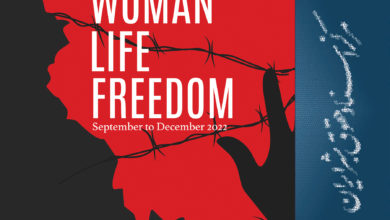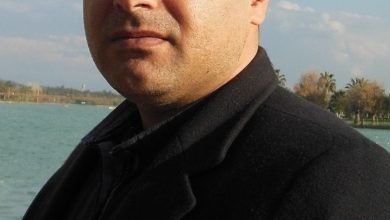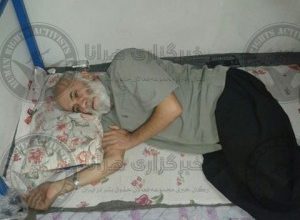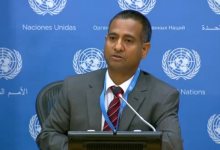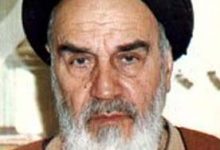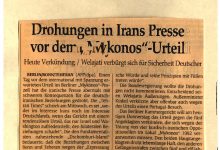Aadel Collection
Iran't Ethnic Factions Threaten to Split the States
Iran's Ethnic Factions Threaten to Split the State: The Multiethnic Fabric of Iran Starts to lJnra .
S ENDERS WTMBUSH
Los 1,, e1e,s linies (1923 Curreiit Fik ) Dec 16 1979
ProQuest Historical Nel%spapers Los Angeles Times (1881 1987)
pg. HI
Iran ‘s Ethnic Factions Threaten to Split the State
By K ENDERS USH
WThule the eyes of the word have been fastened on
the plight of American hostages in Tebran and on
the fanatical city mobs that cheer each new pro
il iiimtimi by Ay 4 vuah Rwiuil Khuw u, Ii , u h b w
slowly fraying at the edges.
No facet of the conflict in Iran is likely to affect the
pos' crisis political environment more fundamentally than
unrest and militancy among that state's important ethnic
minorities, The changing political equation is a very simple
one The dominant Persian majority is rapidly losing its
ability to control events alorg Iran's periphery, which is
inhabited primarily by non Persians.
Ethnic minorities have seized the opportunities resulting
from chaos at the center to advance a variety of local de
mands. In its present state of disarray, the Iranian army
or at least those soldiers and units loyal to Ayatollah
Khomeini, for It should be remembered that Iran's army is
a multiethnic one will probably not be able to contain lo-
cal rebellions for very long, and there is no suggestion that
this sit .ation will Improve in the future
Therefore, the Iran that emerges from the continmng
turmoil will logically contain not one center of power, as in
the shah's time, but several, thereby confronting policy
makers with a complex international dilemma that they
should have addressed long ago and for which they should
have formulated sensible policies and contingency plans.
hr other words, fran, like the majority of the world's coun-
tries, is not an ethnically homogeneous ration but a
diverse multiethnic state
The problem of confusing nations and states is a coin
moo one For example, Americans insistently refer to the
inhabitants of the Soviet Union as “Russians,” when in fact
ethnic Russians constitute less than 50% of the population
and only one of some 140 distinct ethnic groups
A simi ar confusion exists concerning Iran, which is in
habited no only by Persians but also by a number of siza-
ble ‘ninnrities including Azerbaiianis, Kurds, Turkmen,
Arabs and Baluchis, as well as the less-populous Lurs
Bakhtiaria Qashqais and others Demographic data about
these peoples is difficult to find and unreliable.
Azerbaijanis are the largest minority, estimated to num-
ber from 4 million to 5 million. They are followed by the
Kurds, who iiiuiñber between 2½ million and 4 million, the
Arabs, 1½ million; Baluchis, 800,000 and Turkmen, 500,
000 Added to the smaller groups, it is probable that ethnic
minorities comprise as much as one third of the Iranian
population, perhaps more,
Importantly, the larger minorities inhabit strategic hoc
der areas and hence are potentially disruptive of Iran's re
lations with adjacent states, The Kurds have been the most
bothersome in this regard, influencing at various times in
recent history Iran's relations with Iraq, Turkey and Syria.
The Azerbapams are split almost evenly between Iran and
the Soviet Union and have been the center of several ccn-
troversies between those two states in the last five dec-
ades,
Turkmen are also split between the Soviet Union and
Iran, although the great ma only live in the former coun-
try. Baluchis, in southeast Iran, have historically been a
restive force in Iranian politics They are divided i rs ever
charging proportions among Iran, Afghanistan nd Pakis
tan. Iranian Arabs live primarily in the provinte of Khu-
zistan bordering Iraq, but are more worrisome to the au-
thorities because they inhabit and work in Iran's vital oil
producing areas
The current crisis in fran is perhaps a classic example of
a state's multiethnic fabric unraveling under the impact of
a breakdown of central authority and of the speed with
which the infection of ethnic self assertiveness is passed
from group to group.
It is not surprising that the Kurds were the first to press
their national demands on the Khomeini regirse, even to
the point of taking up arms Kurds have long sought a uni
fled national homeland embracing the Kurdish populations
of Iran, Iraq, Syria. Turkey and the Soviet Union. Their
strong historical traditions, distinct language, culture and
religion were at edds with the Iranian practice, which for
ably discourages the observance of cultural tradi.ions that
are not Persian, which requires the teaching of the Persian
language and Persian history in schools, and which accepts
Shia Islam Kurds are Sunni Muslims as the state reli-
gion,
Baluchis and Turkmen, who have similar grievances
against Iranian authorities, were rapidly infected by Kur
dish activities and moved to oppose the reconsolidation of
an imperial Iranian state. Iranian Arabs, who seek to stem
the flow of Persians to Khuzistan a migration that has
relegated the Arabs to a minority in what they consider to
be their own national region joined in with demands of
their own. Thus began an epidemiC of minority protest
which has only this week culminated in an armed rebellion
of the state's largest minonty, the Azerbaijanis
In many respects, the Aserbaijams' protests are ironic
Like the dominant Persians, they are Shia Muslims and,
therefore, they have escaped the religious discranniation
dealt to Kurds, Turksnen, Baluchis and other Sunnites
Moreover, Azerbaijams for many centuries have accept
ed Persian culture the state culture as their own, even
though ethnically they are Turklc and speak a dialect of
Turkish Many of the great Iranian dynasties ;noludnsg
the greatest, the Safavid dynasty have been Turkic, and
Azerbaijan nobility have always been accepted at an equal
level with Persian nobility Today, many prominent Irani-
Please Turn to Page 3, Col, 1
Blocked due to copyrIght.
See full page image or
microfilm
Reproduced with permission of the copyright owner Further reproduction prohibited without permission
Continued from First Page
ans are Azerbaijanis. While the Azerbaijanis have had to
make concessions regarding the use of their distinct lan-
guage and the teaching of their own history, they are for
the most part well-integrated into Persian society, and
most consider themselves Iran ians.
Since the 1920s, there have been several Azerbaijanln-
dependence movements.” although one must approach the
appraisal of these movements with caution. For the most
part, they were the products of Soviet attempts to in-
fluence particular Iranian policy decisions by creating a
specter of internal unrest among Iranian Azerbaijanis,
which the Soviets then could control This was the general
pattern of events surrounding Sheik Mohammed Ithia-
bani's National Democratic Party in 1920, Kuchik Khan's
Soviet Socialist Republic of Ghilan in 1921 and Ja'far Pish-
thv ri' D niocrattc Party ot Azethaijan i t t the 1940s.
There can be no doubt that the participants in these differ-
ent movements sought more autonomy within the Iranian
state or outright separation from it, but there is little
evidence of mass support for the movements.
Not surprisingly, each movement collapsed when the
Soviets withdrew support—including military support In
the case of Pishihvari, the Soviets abandoned him to his
fate when they successfully exacted oil concessions from
the Iranian government This long experience suggests
that the Soviets are not. interested in an Azerbaijani inde-
pendence movement for its own sake, perhaps from fear
that what happens in iranian Azerbaijan could be trans-
mitted across the border to Soviet Azerbaijan.
There has been no acknowledgement to date of Soviet
involvement in the current Azerbaijani protest, and, judg-
ing from the swift escalation of Soviet involvement in Af-
ghanistan, it is difficult to imagine why the Politburo
would want to risk destabilizing another part of the Soviet
b t i T w' th M aby rntrigi it g ii Irat i n AzeTbaijan.
Rather, the current round of Azerbaijani protests ap-
pears to have been suggested by the protests of other eth-
nic minorities—a kind of bandwagon effect—and carried to
arms by the personal feuding of two old men, AyatollaI
Khomeini and the religious leader of Iranian Azerbaijan,
Ayatollah Kazem Shariat-Madari. The Ayatollahs' mutual
antipathy is clearly based in part on rivalry for leadership
of the Islamic revolution, a position Shariat-Madari be-
lieves should be his because he is older than Rhomeini ai d
assisted the younger man to attain his standing as an aya-
tollah. That each man should lay claim to a loyal group of
followers—even to the point of armed conflict—is perfect-
ly within the Shia tradition of emulation for ayatollahs and
unquestioning support of them.
It would seem th matter little that on most of the fun-
damental issues regarding the establishment of an Islamic
republic, the two men are reported to be in concert. The
armed attack on Shariat-Madari's house in Qom several
days ago by tne ni pa t sans was anunpar onab1e pro-
vocation to those who follow the Azerbaijan leader, and
they responded in kind.
Khomeini's charge that the Azerbaijanis supporting Sha-
riat-Madari “were opposed to Islam from the very first
day” is unlikely to cause anything but amusement from
the objects of the attack, all of whom probably are fer-
vently committed to Shiism. Nor is his charge that these
renegades are ‘corrupters of Islam” likely to stir much
more resentment than if one Catholic accused another of
being a bad Christian. But similar blasts at Kurds, Baluchis
or Thrkmen, who are Sunni Muslims, will probably prove
to be much more serious.
By accusing Sunnites of undermining his Islamic revolu-
tion, and by implication of perverting Islam itself,
Khomeini faces the real danger of forcing open a schism
that lies at the very heart of Islamic civilization, the Shia-
Sunni split. To date, Khomeini has judiciously confined
himself to speaking of the brotherhood of Islam,” benign-
ly avoiding mention of a subject that every Muslim knows
lurks just beneath the surface. One slip of his acerbic
tongue could bring this house of cards down, sending non-
Shia ethnic minorities into open opposition to participation
in a new Iranian state and costing Khomeini the moral
support of most of the world's Muslims, who are Sunni.
All dissenting ethnic groups have stressed that their im-
mediate objective is to gain more cultural, linguistic and
political autonomy within an Iranian state. There have
been no outright calls for national separatism, although
same factions of Kurds and Baluchis are known to favor
this course. For them, demands for broader autonomy
within an Iranian federation may be tactical moves de-
signed to secure a forward position in their fight for na-
t ona1 independence. These may be sound tactics and un-
doubtedly will produce same permanent concessions from
whatever government eventually assumes power in Teh-
ran.
However, national independence for these groups ap-
pears no more feasible now than it did before Khomeini
This would require the concurrence and cooperation of
many governments, most of which are themselves unsta-
ble or unwilling to act. Stifi, if conflicts between the re-
belling minorities and the Persian center continue to esca-
late, demands for total national independence will undoub-
tedly be heard, especially from the Kurds.
The situation could be complicated still further if minor-
ity ethnic groups were to ally against Khomeini. At the
present time, it is difficult to imagine any long-term man-
ority alliances because the minorities are themselves di-
vided by religion, language, history and geography.
In the short run, however, the threat of minority alli-
ain t the Persians may force more significant and
more rapid concessions from Khomeini and his successors.
It is probably for this reason that Ayatollah Ezzedin Hos-
semi, the spiritual and political leader of Iran's Kurds, has
stated that the revolution must go on until all major ethnic
groups in Iran win a larger measure of autonomy, implying
that what is good for one is good for all and that the min-
orities must be ready to stand together to achieve their in-
dividual objectives.
For Iran's ethnic minorities, Khomeini's Islamic revolu-
tion offers an exceptionally fluid environment in which
they can press for their own demands with some hope of
realizing them. Thus the situation should be seen for what
it is, a chance to achieve political objectives. While most of
the individuals who compose the different dissenting
groups are devout Muslims, they are not in sympathy with
Khomeini's brand of Islam or his concept of an Islamic
state which would concentrate poler in the hands of a few
religious figures.
Whatever their grievances under the shah, the ethnic
minorities, including the Shia Azerbaijanis, understand
that they stand t gain nothing from such a political ar-
rangement. In fact, their rights and privileges might be
circumscribed even further. Hence their eagerness to
make their respective cases before Khomeini can consoli-
date his power and insist on the implementation of his Is-
lamic constitution.
Civil war between Persians and non-Persians is a possi-
bility, but more moderate voices around Khomeini will
probably not allow the situation to come to that. By now it
is clear to everyone that the Iranian army is incapable of
holding the minorities in check; therefore, the Khomeini
forces will have to accede to some minority demands.
With the minorities in armed opposition, the state can-
not be reconstituted. Furthermore, excessive military acti-
vity in crucial border areas is an invitation for foreign in-
tervention, most logically from the Soviet Union. If civil
war does occur, the likely contenders are the political left
and the devout Muslim right, a conflict that will take place
largely in the major cities.
The Iran that emerges from these upheavals will be
much different from that of the shah's time. If a new state
can be built, it will be one in which minority ethnic groups
play a more important role in the governance of their own
S. Enders Wimbush is a member of the so&l seie,zce de-
partment of Rand Corp., Santa Monica, and is the author of
the recently ptthlished “Mulim National Communism in the
Soviet Un on7 in addiUon to numerous articles on notional-
üy prob1em. . FIis comments i this ariwle reflect lus own
opinions, and not those of the Rand Coip, or its research
spo7 sors.
The Multiethnic Fabric of Iran Starts to Unravel Along the Borders
lives and the management of state affairs. Regional power
centers in Kurdistan, Khuzistan, Azerbaijan and Baluchis-
tan will be in a better position to demand political, cultural
and economic concessions of the Iranian state, for, among
other reasons, the much wider distribution of arms in re-
cent months gives them the power to do so, or at least to
cause the government in Tehran serious difficulties.
International realignments are likely to structure the
way in which Tehran treats important minorities still
further. According to some reports, for example, Iraq, long
the implacable enemy of Kurdish autonomy movements, is
sending aid to Iran's Kurds. Azerbaijanis in Turkey have
indicated their support for their brethren in Iran. In the
east, Baluchis undoubtedly will be affected by the fighting
in Afghanistan and upheavals in Pakistan. And, of course,
looming over all of this is the Soviet Union, which shares
Azerbai aflis, Kurds and Turkmen with han. Should Soviet
leaders feel inclined to promote internal turmoil in Iran or
even to intervene militarily, it is safe to assume that they
will do so through a minority nationality under the guise of
“restoring peace” or of supporting a “frateriial national
liberation movement”
Western statesmen will be forced to come to grips with
these new realities if they hope to influence events and to
reassert their own national interests in this region of the
world.
Moreover, a comxnitment to become more adept in eth-
nic politics should not end with iran, as ethnic unrest there
is symptomatic of the much larger phenomenon of ethnic
self-assertiveness worldwide. Similar patterns are evident
in Southeast Asia, Indonesia, Canada, the Philippines,
Western Europe, the Soviet Union and elsewhere. This is
not by definition a menacing trend; it will become so if we
fail to understand it.
Reproduced with permission of the copyright owner. Further reproduction prohibited without permission.


